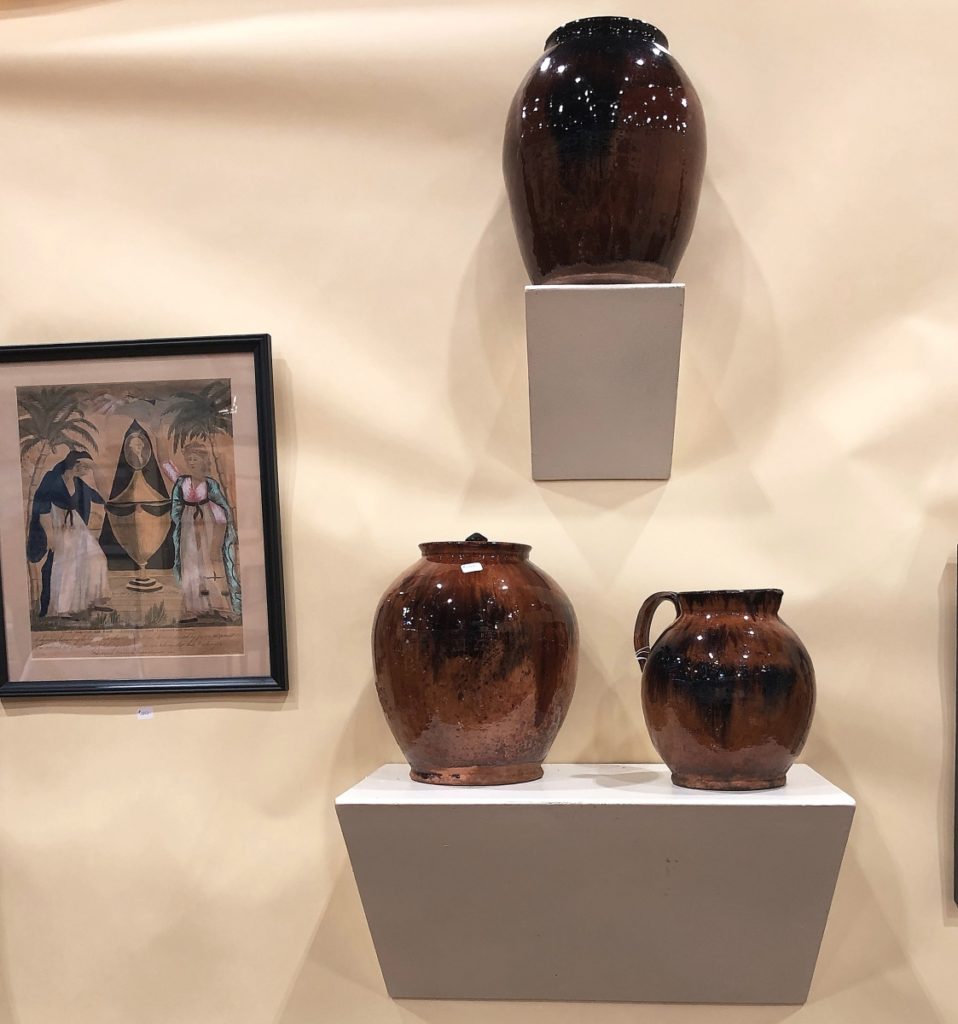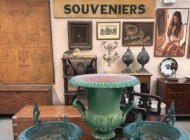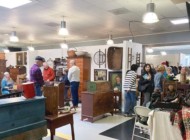
The piece of redware on the right looks like it’s a pitcher but it’s actually a stewpot. There are two reasons to think so: at one time, it had a cover, which most pitchers do not, and the bottom was blackened, indicating that it had been in a cooking fire. Brian Cullity, Sagamore, Mass., was asking $1,450 for it.
Review & Photos by Rick Russack
PORTLAND, MAINE – On September 24-25, Liz and John DeSimone, Goosefare Antiques & Promotions, took their Maine Antiques Exposition to the Portland Expo Center, a location often the home of antiques shows in the past. Covid-19 restrictions and complications with the previously-used facility resulted in the change of venue. The show was slightly smaller than in past editions, with just 36 exhibitors, but the high quality more than offset the fewer dealers, and there were several dealers exhibiting for the first time. Offerings ranged from reference books about antiques to early American furniture to Japanese boro clothing to trade signs to neolithic jade carvings to marine paintings and accessories to early English ceramics to redware, to name a few categories.
Barbara Hepburn, Harrison, Maine, does not do as many shows as her husband, Harry, does. She deals in textiles and at this show she filled her booth exclusively with Japanese boro clothing and you couldn’t help but notice it. The term “boro” refers to Japanese clothing that has been mended and/or patched repeatedly. It is usually clothing worn by rural residents and peasants who could not afford to replace a garment simply because it was torn or ripped; a patch would do. Most of the fabrics used were linen or cotton, the color schemes were blues and muted earth tones and the often mulitple repairs fully evident. Most dated from the 1890s to the 1940s and prices ranged from $250 to $495. A few pieces had painted designs, but most were unadorned.
Brian Cullity, Sagamore, Mass., usually offers early furniture, silver and ceramics, including redware. A redware piece that looked like a pitcher wasn’t. The tag on the piece said it was a “stew pot” and it was priced $1,450. It was standing on a shelf slightly above eye level and when Cullity was asked to explain why he was not calling it a pitcher, said, “When I first saw it I thought it was a pitcher, too. My friend Hilary Nolan told me to turn it over. The blackened base indicated that it had been used for cooking and that was the tip-off as to what it’s use had been. It also had a rim which told me that it should have had a cover, more evidence that it wasn’t a pitcher as they don’t usually have covers. That’s what I love about this business: you’re always learning something new.” He dated it to the early 1800s.

Harry Hepburn, Harrison, Maine, repairs clocks as well as sells them. The walnut tall case clock was made in Rhode Island, circa 1810, and was priced $7,500. He said, “I really like this clock. It’s been in my home for years.”
Marine paintings, half hull models and ship models were available in several booths. David White, North Yarmouth, Maine, had an unusually large model of a six-masted schooner priced at $1,400. It was 65 inches long, had its original rigging and eight lifeboats were hanging on the deck, ready if needed. White said that it was scratch-built, probably around 1900. He also said that it took him hours to clean it when he first got it, as it had been stored away for “years.” One wall of his booth had three half-hull models priced between $300 and $1,400, depending on size; he also had a small pond model priced at $425.
The Captain’s Quarters, Amherst, Mass., always has an interesting assortment of marine accessories and sailor made items, along with sailor’s valentines. They also had one of the exceptional ship paintings they are known for. The large oil on canvas by William Gay Yorke (1817-circa 1888) of the medium clipper Mary inbound off the Skerries, England. It was signed and dated 1859. A catalog picturing the painting indicated that the Mary was one of only three clipper ships built in Marblehead, Mass., and it was launched in 1854.
Dennis Raleigh and Phyllis Sommer, Searsport, Maine, had a very well made, detailed, copper weathervane of a lighthouse with the keeper’s house and an arrow directional. It was made in the late Twentieth Century and was priced at $2,250.
From Harrison, Maine, Harry Hepburn had three detailed carvings of whales done by an apprentice of Wick Ahrens (1944-2016). He was asking $395 for the group.

Barbara Hepburn, Harrison, Maine, filled her booth with Japanese boro garments. These were garments used by rural residents and were repaired and patched, often more than once, to extend their usefulness. Prices ranged from $250 to $495.
Willow Springs Perennial Antiques, Rexford, N.Y., was one of the dealers with a grouping of sailor’s valentines. In addition to several pieces of mocha ware, they also had a collection of Staffordshire whippet figures, for which they were asking between $200 and $400 each.
You could have expected to find a wide assortment of folk art and you would not have been disappointed. Ed Pollack Fine Arts, Portland, Maine, had a circa 1998 carved group of Adam and Eve being expelled from the Garden of Eden. It was comprised of wood, wire, leather and other materials, in typical Outsider art style. It had been made by Tom Kelly, who died in 1998. Pollack said Kelly suffered mental and emotional problems, lived with his parents in Massachusetts and committed suicide shortly after completing this work. This piece was acquired from Kelly’s family, along with other works, after his death. Pollack priced the group at $875.
Hooked and sheared rugs were available in several booths. One of the nicest depicted a Dalmatian at rest with a bright red background. It was being offered by MG Antiques, Merrimac, Mass., who had priced it $995. Pat Stauble, Edgecomb, Maine, brought a brightly colored one-drawer covered box with a black and possibly stenciled bird, which she priced at $235. Bob Foley, Gray, Maine, had a large, welded steel giraffe, close to 6 feet tall. It might have been an example of midcentury folk art or it may have a been a store display fixture, as Foley suggested. It was certainly one of a kind, and Foley was asking $695. He thought it dated to the 1950s or 1960s.
Early ceramics were available in several booths, with one of the largest selections being in the booth of Jim Dolph, JSD Antiques, Portsmouth, N.H. One of his showcases included a variety of Wedgwood in seldom-seen colors. A group of tri-color Jasper ware, produced around 1875, was priced between $300 and $750. A group of crimson-colored pieces made in the early Twentieth Century was marked between $225 and $1,100. In addition, his booth had a wide assortment of Asian ceramics and carved jade, some of which dated back to neolithic times.

Nancy Davis, Willow Springs Perennial Antiques, Rexford, N.Y., had a collection of Staffordshire whippet figures which were priced between $200 and $400 each as well as several pieces of mocha ware.
Red sold tags were apparent in several booths shortly after the show opened. Some of those dealers with early sales included Bob Markowitz, Pumpkin Patch Antiques, Willow Springs, David White, Martin Ferrick and others.
A few days after the show, John DeSimone reported, “It felt good being back at the Expo Center. We used to run shows there years ago. It’s a good location and everyone knows where it is. We had some scheduling conflicts this time which we’ll work to eliminate next year. Several of the exhibitors told us that they had had a good show and we were all pleasantly surprised at the strength of the retail buyers, many of whom came in on Sunday.”
Goosefare Antiques & Promotions’ next show – and its last of the year – will be the 24th Needham Antiques Show & Sale on November 13.
For additional information, www.goosefareantiques.com or 800-641-6908.





























